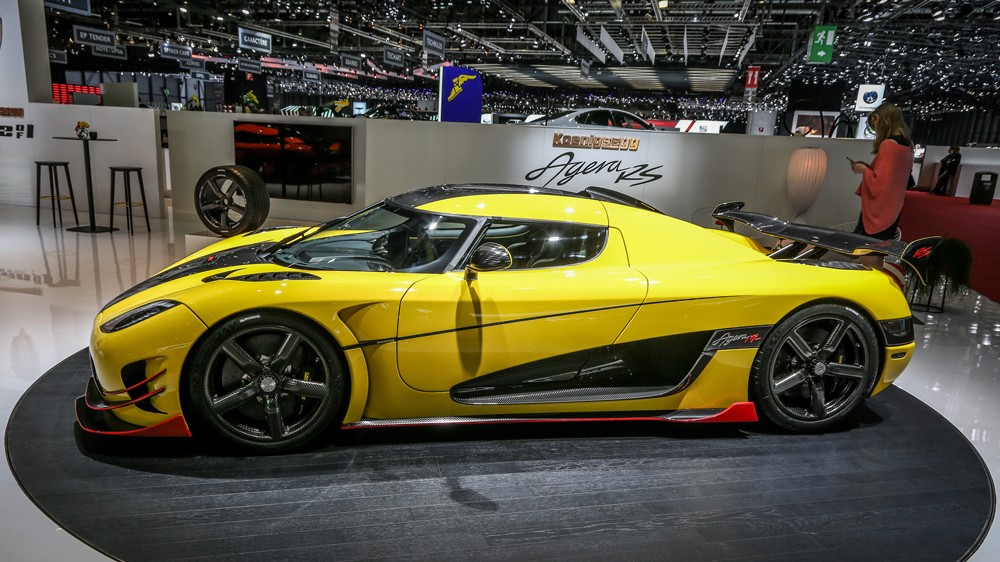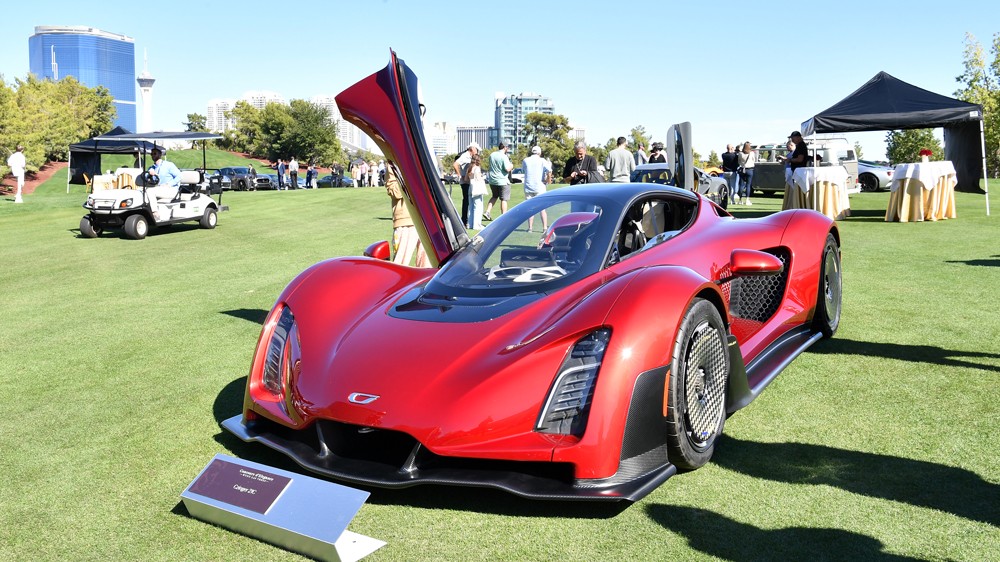The fastest production car represents the pinnacle of automotive engineering, pushing the boundaries of speed, power, and aerodynamics. At CARS.EDU.VN, we help you explore how these automotive marvels are created. Ready to experience the thrill? Keep reading to uncover the incredible machines that have captured the crown in the high-speed chase, with discussions of top speed runs and record-breaking cars.
1. Unveiling the Quest for Speed: What Drives the Fastest Production Car?
The pursuit of the fastest production car is more than just a race; it’s a showcase of technological prowess, engineering innovation, and the relentless human desire to push boundaries. At CARS.EDU.VN, we delve into the science and passion that fuel this quest. Several factors play crucial roles in determining the title holder, including:
- Engine Power: The heart of any speed record attempt lies in its engine. High horsepower and torque are essential to overcome air resistance and achieve blistering speeds.
- Aerodynamics: Efficient aerodynamics are crucial to minimize drag and maximize downforce, ensuring stability at extreme velocities.
- Weight: A lighter car accelerates faster and handles better. Advanced materials like carbon fiber and titanium are employed to reduce weight without sacrificing strength.
- Tires: Specially designed tires are needed to withstand the immense stresses and heat generated at such high speeds.
- Transmission: A robust and responsive transmission system is vital to efficiently transfer power from the engine to the wheels.
2. The Reigning Champions: Fastest Production Cars on the Planet
The title of the fastest production car has been fiercely contested over the years. Here’s a look at some of the frontrunners. Note that some speeds are claimed by manufacturers and are awaiting independent verification:
| Rank | Car | Claimed Top Speed (MPH) | Notes |
|---|---|---|---|
| 1 | Koenigsegg Jesko Absolut | 330+ | Aerodynamically optimized for top speed; Expected to make a new speed run in 2024 |
| 2 | Bugatti Bolide | 311+ | Lightweight design with focus on track performance |
| 3 | Bugatti Chiron Super Sport | 304.7 | Achieved on the Ehra-Lessien track with modifications |
| 4 | Hennessey Venom F5 | 300+ | Powered by a 6.6-liter twin-turbo V-8 |
| 5 | SSC Tuatara | 295 (Contested) | Originally claimed higher speeds, but figures were disputed; Averages 282.9 mph after re-evaluation |
| 6 | Koenigsegg Agera RS | 277.8 | Achieved on a closed road in Nevada |
| 7 | Hennessey Venom GT | 270.4 | Reached at the Kennedy Space Center, but not officially recognized due to one-way run |
| 8 | Bugatti Veyron Super Sport | 267.8 | Held the record for a time; Required a special key to unlock max speed |
| 9 | Bugatti Mistral | 261 (Claimed, Roof off) | Roadster version; Final application of the quad-turbo W-16 engine before Bugatti’s hybridization |
| 10 | Rimac Nevera | 258 | All-electric hypercar; Also the world’s fastest-accelerating production car |




3. Koenigsegg Jesko Absolut: Aiming for the Crown
The Koenigsegg Jesko Absolut is engineered to achieve unparalleled speeds. CARS.EDU.VN dives deep into what makes this car a contender for the fastest production car title:
- Aerodynamic Enhancements: The Jesko Absolut boasts a streamlined profile with minimal drag, allowing it to slice through the air effortlessly.
- Powerhouse Engine: Its 5.0-liter twin-turbo V-8 engine delivers an astounding 1,600 horsepower when running on E85 biofuel.
- Light Speed Gearbox: Koenigsegg’s innovative Light Speed Gearbox ensures rapid and seamless gear changes, maximizing acceleration and top speed.
- Stability: It is built for increased stability by tweaking the aerodynamics and reducing drag.
4. Bugatti: A Legacy of Speed and Luxury
Bugatti has long been synonymous with extreme speed and opulent luxury. Several models have held or challenged for the title of the fastest production car. At CARS.EDU.VN, we appreciate the marque’s commitment to pushing the limits. Key Bugatti models include:
4.1. Bugatti Chiron Super Sport
This hypercar achieved a verified top speed of 304.7 mph.
- Engine: 8.0-liter quad-turbocharged W-16 engine producing 1,600 horsepower.
- Modifications: Extended body, lowered suspension, and enhanced aerodynamics.
- Tires: Michelin Pilot Sport Cup 2 tires x-rayed for perfect structural integrity.
4.2. Bugatti Veyron Super Sport
This model previously held the record for the fastest production car.
- Engine: Enhanced W-16 engine producing 1,184 horsepower.
- Key Feature: Required a special key to unlock the engine’s full potential.
- Achievement: Secured the accolade of the fastest production car ever built, according to Guinness.
4.3. Bugatti Bolide
Inspired by the Vision Le Mans concept.
- Design: Fantastical X-themed design language.
- Materials: Lightweight monocoque incorporating titanium and carbon fiber.
- Performance: Estimated top speed in excess of 311 mph.
4.4. Bugatti Mistral
Marks the end of an era with the quad-turbo W-16 engine.
- Design: Features significant revisions to Bugatti’s established design language.
- Aerodynamics: Designed for sufficient downforce and engine cooling.
- Top Speed: Aims to achieve 261 mph with the roof off.
5. Hennessey Performance: American Muscle Meets Hypercar Engineering
Hennessey Performance is known for its obsession with power and speed. CARS.EDU.VN admires their boldness in creating extreme machines. Two models stand out:
5.1. Hennessey Venom GT
This car achieved a top speed of 270.4 mph at the Kennedy Space Center.
- Engine: 7.0-liter twin-turbo GM V-8 producing 1,244 horsepower.
- Record Attempt: Reached 270.4 mph in one direction, but did not qualify for official record books.
- Production: Only 13 units were sold, falling short of the required production volume for record validation.
5.2. Hennessey Venom F5
Aims to exceed 300 mph.
- Engine: 6.6-liter twin-turbo V-8 producing 1,817 horsepower.
- Performance: Can accelerate to 60 mph in under two seconds.
- Name: Named after the F5 category of tornados.
6. SSC North America: The Pursuit of Redemption
SSC North America has been determined to break speed records. CARS.EDU.VN follows their journey with interest.
6.1. SSC Ultimate Aero TT
This model once held the Guinness Book of Records-verified top speed.
- Engine: Twin-turbocharged Corvette C5R V-8 producing more than 1,100 horsepower.
- Record: Verified top speed of 256.18 mph.
- Design: Features twin air brakes that pop up from the rear wings.
6.2. SSC Tuatara
This hypercar has faced controversy and scrutiny in its record attempts.
- Initial Claim: Initially claimed an average speed of 316.11 mph.
- Controversy: The initial claim was met with skepticism and data analysis.
- Redux: Subsequent trial resulted in an average speed of 282.9 mph.
7. Rimac Nevera: The Electric Revolution
The Rimac Nevera is proving that electric cars can compete at the highest levels of performance. At CARS.EDU.VN, we’re excited about the future of electric hypercars.
- Power: Boasts twice the power of a Formula 1 car.
- Acceleration: Can hit 60 mph in under two seconds.
- Grand Tourer: Designed to be a highly usable, no-fuss grand tourer.
- Horsepower: 1,914 hp Nevera is currently the world’s fastest-accelerating production car.
8. The McLaren F1: A Timeless Icon
The McLaren F1 remains a benchmark for supercar design and performance. CARS.EDU.VN recognizes its lasting influence.
- Revolutionary Design: The iconic three-seater was designed by Gordon Murray.
- Materials: The first carbon-fiber-bodied production car ever built.
- Engine: 6.1-liter V-12 from BMW producing 618 horsepower.
- Record: Officially set the world speed record back in 1998.
9. Czinger Vehicles: Revolutionizing Manufacturing
Czinger Vehicles aims to transform the automotive industry using innovative manufacturing techniques. At CARS.EDU.VN, we are impressed by their vision.
9.1. Czinger 21C V Max
American hypercar start-up Czinger Vehicles aims to completely revolutionize the automotive industry by introducing the sustainable use of 3-D-printing and AI-assisted designs in mass production.
- Body: Smoother and longer aerodynamic body for the 21C.
- Engine: Twin-turbocharged 2.88-liter V-8 paired with dual electric motors.
- Horsepower: Combination delivers a total of 1,250 hp to all four wheels.
- Dry Weight: Low dry weight of 2,756 pounds.
- Performance: Czinger claims the V Max should be able to sprint to 60 miles per hour in under 1.9 seconds and achieve a top speed of 253 mph.
10. Other Notable Contenders in the High-Speed Race
Besides the leading contenders, other cars have also made significant contributions to the pursuit of speed.
| Car | Top Speed (MPH) | Notes |
|---|---|---|
| Saleen S7 Twin Turbo | 248 | One of the first American mid-engined performance machines ever crafted |
| Koenigsegg CCXR | 249 | Uses a modified engine to run on E85 race gas, producing 1,004 hp |
| Koenigsegg Gemera | 249 (Claimed) | Referred to as a “mega GT” with four seats |
| Tesla Roadster | 250+ (Claimed) | Electric coupe with a claimed range of up to 620 miles |
| Aston Martin Valkyrie | 250 (Claimed) | Hypercar developed in collaboration with Red Bull Racing |
| McLaren Speedtail | 250 | Hybrid system with sleek shape and lightweight carbon-fiber construction |
| Pagani Huayra BC Roadster | 240 (Estimated) | Open-top hypercar with a new Mercedes-AMG twin-turbo V-12, tweaked to be more powerful than the coupe version of the BC. |
| Pagani Huayra | 238 | Successor to the Zonda, named after a Quechua wind god |
| Gordon Murray Automotive T.50 | 230 (Claimed) | Designed by the creator of the McLaren F1, featuring a lightweight body |
| Lamborghini Aventador LP 780-4 Ultimae | 221 | Pinnacle performance variant of the Aventador, retaining all-wheel drive |
| Aston Martin One-77 | 220 | Limited-edition coupe with only 77 units produced |
| Porsche 918 Spyder | 218 | Hybrid powertrain with a naturally aspirated 4.6-liter V-8 and twin electric motors |
11. The Science of Speed: Key Technological Innovations
Achieving record-breaking speeds requires advanced engineering and technological innovations. CARS.EDU.VN explores some of the key elements:
- Advanced Aerodynamics: Active aero systems, like adjustable wings and diffusers, optimize airflow and downforce.
- Lightweight Materials: Carbon fiber, titanium, and other advanced materials reduce weight and increase strength.
- Hybrid and Electric Powertrains: Hybrid and all-electric powertrains deliver instant torque and high power output.
- Advanced Tire Technology: Specially designed tires withstand extreme speeds and temperatures.
- Electronic Control Systems: Sophisticated electronic control systems manage various aspects of performance, including engine management, traction control, and stability control.
12. The Human Factor: Drivers and Teams
Behind every successful speed record is a dedicated team and a skilled driver. CARS.EDU.VN acknowledges the human element in this quest.
- Experienced Drivers: Drivers must possess exceptional skills and courage to handle these powerful machines at their limits.
- Dedicated Teams: Engineers, technicians, and support staff work tirelessly to optimize the car and ensure a successful run.
- Collaboration: Close collaboration between drivers and teams is essential for fine-tuning the car and achieving the best possible performance.
13. The Future of Speed: What’s Next?
The quest for the fastest production car is far from over. CARS.EDU.VN looks ahead to future trends and innovations.
- Electric Hypercars: Electric hypercars are poised to dominate the high-speed landscape with their instant torque and increasing range.
- Sustainable Technologies: Manufacturers are exploring sustainable materials and technologies to reduce the environmental impact of high-performance vehicles.
- Artificial Intelligence: AI is being used to optimize car design and performance, pushing the boundaries of what’s possible.
- New Contenders: New manufacturers and technologies are constantly emerging, promising even faster and more exciting cars in the future.
14. Safety Considerations: Protecting Drivers at Extreme Speeds
Safety is paramount in high-speed record attempts. CARS.EDU.VN emphasizes the importance of safety features and protocols.
- Advanced Safety Cells: Strong and lightweight safety cells protect the driver in the event of a crash.
- Racing Harnesses: Multi-point racing harnesses secure the driver in the seat.
- Fire Suppression Systems: Automatic fire suppression systems quickly extinguish fires.
- Aerodynamic Stability: Aerodynamic design ensures stability and prevents lift at high speeds.
- Tire Technology: High-performance tires are designed to withstand extreme temperatures and pressures.
15. The Economics of Speed: The Price of Performance
The fastest production cars come with a hefty price tag. CARS.EDU.VN examines the economics of these high-performance machines.
- High Development Costs: Developing and engineering these cars requires significant investment.
- Exotic Materials: The use of exotic materials like carbon fiber and titanium drives up costs.
- Limited Production: Limited production runs increase exclusivity and price.
- Luxury Features: Many of these cars also come with luxurious interiors and advanced technology, adding to the cost.
16. The Marketing of Speed: Branding and Image
The title of the fastest production car is a powerful marketing tool. CARS.EDU.VN explores how manufacturers leverage this achievement.
- Brand Image: Setting a speed record enhances brand image and attracts customers.
- Marketing Campaigns: Manufacturers use speed records in marketing campaigns to promote their cars.
- Exclusivity: Limited production and high prices create an aura of exclusivity.
- Technological Showcase: Speed records showcase a manufacturer’s technological prowess.
17. Famous Speed Records and the Stories Behind Them
Throughout history, numerous speed records have been set, each with its own unique story. CARS.EDU.VN highlights some of the most memorable.
- ThrustSSC: The first car to break the sound barrier, achieving a speed of 763 mph in 1997.
- Bugatti Veyron: Held the record for the fastest production car for many years.
- Koenigsegg Agera RS: Set multiple records, including the fastest zero-to-250 mph-to-zero time.
- SSC Tuatara: Faced controversy but ultimately achieved a verified top speed.
18. How to Choose the Right High-Performance Car for You
While the fastest production cars are impressive, they may not be practical for everyday driving. CARS.EDU.VN offers guidance on choosing the right high-performance car for your needs.
- Consider Your Needs: Determine how you will use the car and what features are important to you.
- Set a Budget: High-performance cars can be expensive, so set a realistic budget.
- Research Models: Research different models and compare their features and performance.
- Test Drive: Test drive several cars to see which one you like best.
- Consider Maintenance: High-performance cars can be expensive to maintain, so factor that into your decision.
19. Maintenance Tips for High-Performance Cars
Owning a high-performance car requires meticulous maintenance. CARS.EDU.VN provides essential tips to keep your car running smoothly.
- Regular Oil Changes: Change the oil regularly using high-quality synthetic oil.
- Check Fluid Levels: Regularly check and top off all fluid levels, including coolant, brake fluid, and power steering fluid.
- Inspect Brakes: Inspect the brakes regularly and replace pads and rotors as needed.
- Tire Care: Maintain proper tire pressure and rotate tires regularly.
- Professional Service: Have your car serviced by a qualified technician who specializes in high-performance vehicles.
20. The Debate: Top Speed vs. Overall Performance
While top speed is impressive, it’s not the only measure of a car’s performance. CARS.EDU.VN discusses the importance of overall performance.
- Acceleration: How quickly a car can accelerate from a standstill.
- Handling: How well a car handles in corners and on winding roads.
- Braking: How quickly a car can come to a stop.
- Ride Quality: How comfortable the ride is.
- Overall Balance: The combination of all these factors to create a well-rounded driving experience.
21. The Impact of Regulations on High-Speed Cars
Government regulations play a significant role in the design and development of high-speed cars. CARS.EDU.VN examines the impact of these regulations.
- Safety Standards: Cars must meet certain safety standards to be sold in a particular market.
- Emissions Standards: Cars must meet certain emissions standards to be environmentally friendly.
- Speed Limits: Speed limits on public roads limit the practical use of high-speed cars.
- Crash Testing: Cars must pass crash tests to ensure they are safe in the event of an accident.
22. The Cultural Significance of the Fastest Cars
The fastest cars in the world are more than just machines; they are cultural icons. CARS.EDU.VN explores their cultural significance.
- Dream Cars: They represent the ultimate in automotive achievement.
- Inspiration: They inspire engineers and designers to push the boundaries of what’s possible.
- Status Symbols: They are status symbols for the wealthy and successful.
- Entertainment: They provide excitement and entertainment for car enthusiasts.
23. Top Speed Runs: Where and How Are They Conducted?
Top speed runs are carefully planned and executed events. CARS.EDU.VN describes the process.
- Closed Courses: Top speed runs are typically conducted on closed courses, such as test tracks or abandoned airfields.
- Professional Drivers: Experienced drivers are used to pilot the cars.
- Data Recording: Data is carefully recorded to verify the speed.
- Safety Measures: Extensive safety measures are put in place to protect the driver and the team.
24. Debunking Myths About the Fastest Cars
There are many myths and misconceptions about the fastest cars in the world. CARS.EDU.VN sets the record straight.
- Myth: They Are Unsafe: Modern high-speed cars are designed with advanced safety features.
- Myth: They Are Impractical: Some high-speed cars can be surprisingly practical for everyday driving.
- Myth: They Are Only About Speed: High-speed cars often offer a combination of speed, luxury, and technology.
- Myth: They Are All the Same: Each high-speed car has its own unique personality and driving experience.
25. Staying Updated: The Latest News and Developments
The world of high-speed cars is constantly evolving. CARS.EDU.VN provides the latest news and developments.
- New Models: Manufacturers are constantly developing new models with even higher performance.
- Record Attempts: New record attempts are always on the horizon.
- Technological Innovations: New technologies are constantly being developed to improve speed and performance.
CARS.EDU.VN is your ultimate resource for all things automotive. We strive to provide the latest news, in-depth analysis, and expert advice.
Facing challenges in finding reliable car services or staying updated with automotive tech? At CARS.EDU.VN, we understand the difficulties in keeping up with car maintenance and the latest automotive trends. We offer detailed guides, expert reviews, and a directory of trusted service providers to help you make informed decisions and keep your vehicle in top condition.
Ready to explore more and enhance your automotive knowledge? Visit CARS.EDU.VN today for a wealth of information and services designed to make your car ownership experience smoother and more enjoyable.
Contact Us:
- Address: 456 Auto Drive, Anytown, CA 90210, United States
- WhatsApp: +1 555-123-4567
- Website: cars.edu.vn
FAQ: Frequently Asked Questions About the Fastest Production Car
- What exactly defines a “production car?” A production car is a vehicle that is manufactured in significant numbers (typically hundreds or thousands) and available for purchase by the general public.
- Why is top speed so important in the automotive world? Top speed is a benchmark of engineering excellence and technological advancement, showcasing the limits of what’s currently possible.
- How are top speeds officially measured and verified? Top speeds are usually measured on a long, straight track with sophisticated GPS and timing equipment. Independent organizations often verify the results to ensure accuracy.
- What safety measures are in place during top speed record attempts? Safety measures include professional drivers, closed courses, advanced safety equipment, and extensive pre-run inspections.
- Are the fastest production cars practical for everyday use? While some can be surprisingly practical, many are designed primarily for performance and may not be ideal for daily commuting.
- What is the role of aerodynamics in achieving high speeds? Aerodynamics are crucial for minimizing drag and maximizing downforce, enabling stability and higher speeds.
- How do hybrid and electric powertrains contribute to top speed? Hybrid and electric powertrains offer instant torque and high power output, contributing to faster acceleration and higher top speeds.
- What are some of the technological innovations used in the fastest cars? Innovations include advanced aerodynamics, lightweight materials, powerful engines, and sophisticated electronic control systems.
- How does the weight of a car affect its top speed? A lighter car accelerates faster and is more nimble, leading to higher potential top speeds.
- What impact do government regulations have on the development of these cars? Regulations related to safety, emissions, and noise can influence the design and engineering of high-speed cars.
